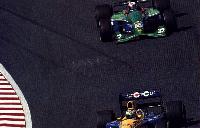Great American hero
Author
- Mattijs Diepraam
Date
- 8W February 1999 issue
Related articles
- Andrea Montermini - A victim of 1994, by Mattijs Diepraam
Who?Michael Schumacher, Alessandro Zanardi What?Benetton-Ford B191, Jordan-Ford 191 Where?Suzuka When?1991 Japanese GP |
 |
Why?
Two multiple champions caught in one shot but long before being famed as F1's and CART's hardest chargers of the day...
In the autumn of 1991, both Schumacher and Zanardi had first set foot on holy F1 ground. And what a difference it was! While young Michael was immediately hunted after as F1's hottest property, Alessandro was just another replacement driver in the Jordan seat involuntarily vacated by Bertrand Gachot. With Zanardi desperately hanging onto F1's tail at Minardi and Lotus, Michael Schumacher carved himself a niche at Benetton, taking two more years to create a championship-winning atmosphere his team mates will remember for the rest of their careers.
When underlining the contrast between the German and the Italian, everyone likes to tell how Alex got thrashed by Johnny Herbert at Lotus. But his critics tend to forget that Zanardi was on a par with the Briton until his massive crash at Spa, needing more than a year to fully recover. Wasn't it Herbert who got sidelined in his first year in F1 because of the consequences of that huge multi-car F3000 shunt at Brands? Zanardi's team boss at the time, Peter Collins of Lotus, still raves about Alex' testing skills and car control.
It was this that convinced Chip Ganassi to sign the man from Bologna as a back-up to Jimmy Vasser's 1996 CART assault. It turned out as an inspired move - probably the best hunch Ganassi ever had and will have, with nothing more to base his judgement on than a successful winter test. With an unproven record in F1 and a year of anonimity and the occasional GT drive, Zanardi had nothing to show for. But he grabbed the lifeline thrown by Ganassi and by the end of 1996 had pulled himself up to dizzying heights.
Since becoming championship contenders, Schumacher and Zanardi have had more in common than one might think. First, there's the ruthlessness in dealing with their opponents. Both "Schumi" and Alex are known for their forceful tactics. Over the years they got embroiled in numerous contretemps with their rivals in F1 and CART, who on many occasions accused them of dangerous driving, unworthy of champions. Their first titles were gained amidst the controversy of turfing others off the road - their victims (if so) the first to tell the world that men of their substantial talent do not need to resort to bullying.
But often it is just this kind of uncompromising attitude on the track that turns ordinary men into winners. And with most of the incidents open to debate, both Schumacher and Zanardi have room to justify their wheel-banging actions. Secondly, there is the drive to utterly dominate - as they did in the second of their back-to-back titles, both championships underlining their unquestionable number one status. Thirdly, they both have shown superior strategical insight, with many of their wins the result of clever pit strategy.
Oddly enough, while Zanardi before his accident was generally seen as a pleasant and ambitious young man and an admirable hard racer with an almost unmediterrean analytical mind, Schumacher is widely regarded as the evil, money-grabbing "Kraut" with total disregard for fair play. Is it that far back that we cannot remember Spa 1992? Back then a pleasant and ambitious young man climbed the top step, cheering, showing the clenched fists now seen as arrogant, genuinely enjoying his first victory - a sight refreshing to behold in the Senna-Prost-Mansell era of bland and cold-shouldered podium ceremonies, everyone agreed at the time. How things change…
